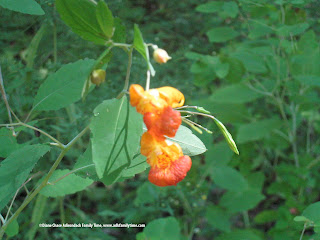Adirondack Nature Detective: Jewelweed Natural remedy for Poison Ivy
By Diane Chase
One of the Adirondack Fun Facts covered in my guidebook Adirondack Family Time: Tri-Lakes and High Peaks (Your Four-Season Guide to Over 300 Activities) is that Jewelweed (Impatiens capentis) has been used as a treatment for poison ivy for centuries.
Jewelweed is commonly known as "Touch-me-Not" or "Silverleaf." Touch Me Not because the tiny seed pods will explode when touched "like fireworks." Children will love to watch the seed pop open and you can know that the plant has other benefits as well.
Another common name is Silverleaf. Put the leaf under water and its tiny "hairs" will repeal water, taking on a silver appearance. Take it out and the leaf is dry. Children will love to see this miracle while on the trail.
How to identify
• the leaves are oval with round-tooth edges
• the flower is orange with a yellowish head and red spots in the "mouth." It looks similar to a snapdragon
• the leaves alternate at the stem toward the top
• the flower is about 1" long and has three petals.
• Usually grows in wooded areas and near water.
Uses
•Leaves and juice from the stem are used to treat rashes such as poison ivy, stinging nettle, poison oak and will even sooth bug bites.
• The seeds are edible and taste a bit nutty but won't provide a meal as they are so tiny.* Discard the coil part.
Interesting Fact
• Mother Nature provides. Jewelweed can usually be found near poison ivy so there is no need to wait if you are exposed. Just rub it on the affected part and it is said to help stop the Urushiol oils from spreading, which causes the irritation.
• There are two types of Jewelweed, yellow and orange. The orange flowered jewelweed is said to have a more potent effect on irritation.
Home Remedy
•Boil chopped up Jewelweed until it turns a dark orange to make an infusion, strain and freeze in ice cube trays. Store in a freezer bag for later use. It will keep for up to one year.
*Caution: Please use common sense when using home remedies. Do an allergy test on a small patch of skin before rubbing anything on your body. Never eat anything on the trail unless you are positive of the plant identification and realize the risks. This remedy is given here for educational purposes only. I am not a medical professional though I do experiment on my family members. (rubbing hands together like mad scientist while throwing head back with glee.)
© Diane Chase, author of Adirondack Family Time: Tri-Lakes and High Peaks (Your Four-Season Guide to Over 300 Activities) available online or bookstores/museums July 2011. Diane is currently working on the second guidebook in the proposed four book series of Adirondack Family Activities.
One of the Adirondack Fun Facts covered in my guidebook Adirondack Family Time: Tri-Lakes and High Peaks (Your Four-Season Guide to Over 300 Activities) is that Jewelweed (Impatiens capentis) has been used as a treatment for poison ivy for centuries.
Jewelweed is commonly known as "Touch-me-Not" or "Silverleaf." Touch Me Not because the tiny seed pods will explode when touched "like fireworks." Children will love to watch the seed pop open and you can know that the plant has other benefits as well.
Another common name is Silverleaf. Put the leaf under water and its tiny "hairs" will repeal water, taking on a silver appearance. Take it out and the leaf is dry. Children will love to see this miracle while on the trail.
How to identify
• the leaves are oval with round-tooth edges
• the flower is orange with a yellowish head and red spots in the "mouth." It looks similar to a snapdragon
• the leaves alternate at the stem toward the top
• the flower is about 1" long and has three petals.
• Usually grows in wooded areas and near water.
Uses
•Leaves and juice from the stem are used to treat rashes such as poison ivy, stinging nettle, poison oak and will even sooth bug bites.
• The seeds are edible and taste a bit nutty but won't provide a meal as they are so tiny.* Discard the coil part.
The seeds are even said to be edible but it takes a quick hand to catch them and you'd go hungry if you were depending on them for a meal.
We find it to be a fun "on the trail" game to pop and catch the seeds.*
Interesting Fact
• Mother Nature provides. Jewelweed can usually be found near poison ivy so there is no need to wait if you are exposed. Just rub it on the affected part and it is said to help stop the Urushiol oils from spreading, which causes the irritation.
• There are two types of Jewelweed, yellow and orange. The orange flowered jewelweed is said to have a more potent effect on irritation.
Home Remedy
•Boil chopped up Jewelweed until it turns a dark orange to make an infusion, strain and freeze in ice cube trays. Store in a freezer bag for later use. It will keep for up to one year.
*Caution: Please use common sense when using home remedies. Do an allergy test on a small patch of skin before rubbing anything on your body. Never eat anything on the trail unless you are positive of the plant identification and realize the risks. This remedy is given here for educational purposes only. I am not a medical professional though I do experiment on my family members. (rubbing hands together like mad scientist while throwing head back with glee.)
© Diane Chase, author of Adirondack Family Time: Tri-Lakes and High Peaks (Your Four-Season Guide to Over 300 Activities) available online or bookstores/museums July 2011. Diane is currently working on the second guidebook in the proposed four book series of Adirondack Family Activities.





Comments